

On 27th July 1949, the de Havilland Comet took its maiden flight, and was introduced with BOAC on 2nd May 1952, to become the world’s first commercial jetliner, carrying up to 109 passengers and 4 crew. Length 112ft, wingspan 115ft, height 30ft, dry weight 75,400lb, powerplant: 4×Rolls–Royce Avon Mk524 turbojets delivering 10,500lbf each (total 42,000lbf), max speed 500mph, and service ceiling 40,000ft.
By comparison, the James Comet was first announced in the Motor Cycle on 21st October 1948, and became available for delivery in early April 1949, pre-dating the de Havilland Comet by over 3 years. With a dry weight of 100lb (making it over 21 tons lighter), installed with the new Villiers 1F, 2-gear, 98cc 2-stroke engine at 8:1 compression, producing 2.8bhp, and offering 144mpg even when ridden flat out, it was far more efficient—though with a given top speed of 40mph (rated at ground level), it was admittedly a little slower.
Being strictly historically accurate, the James machine announced in the Motor Cycle in October 1948 wasn’t actually called the Comet at that time, being simply described as Model 1F ‘Standard’ with direct lighting, and another Model 1F ‘De-Luxe’ version featuring battery and rectifier for consistent DC illumination.
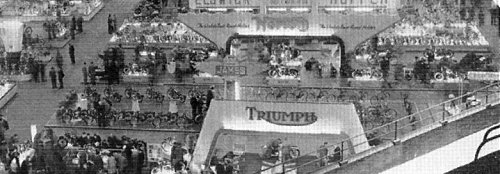
Just before the doors open: the James stand at the 1948 show
When the Earls Court Motor Cycle Show opened its doors on 18th November 1948, a 1F ‘Standard’ model was displayed on the stand number 12 between Norton and Triumph, but James adverts made no mention of any further detail over the following months, simply referring to ‘the James 1949 lightweights’. A full-page advert published in the Motor Cycle on 10th February 1949 still made no mention of model details, and the accompanying picture continued to illustrate the obsolete ML machine!

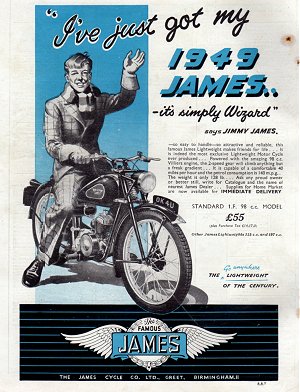
James adverts from 1949.
In February, Jimmy James is still riding the old ML model
but, by April, he has the new 1F model.
The Motor Cycle printed a road test on 3rd March 1949, then on 7th April appeared a picture of the 1F machine in a full page advert, saying ‘Supplies for Home Market are now available for immediate delivery’ (the implication being that they had probably not been available previously, though some may have been supplied earlier to meet customers’ orders on any waiting list). Though this advert primarily featured the ‘Standard 1F’, it also mentions ‘other James Lightweights of 125cc and 197cc’. No word about the ‘De-Luxe 1F’ appeared in this or subsequent adverts, until 25th August, suggesting a delayed introduction of this second model.
It was not until 13th October 1949 that the Comet name actually appeared in a Motor Cycle description of the 1950 James range, the week before the 1949 Earls Court Show, and a whole year after the model was first announced. Finally, the new baby had been christened!
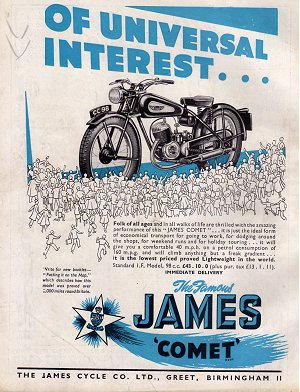
December 1949 and the ‘Comet’ name appears in a James
advert.
A new variant was created for 1951 by fitting the Comet with enclosure panels, leg shields and valanced rear mudguard, to become the J4 Commodore.
For 1953, the ‘Standard’ Comet became designated the J10 (or MkII), while the ‘De-Luxe’ version became the J3, and was fitted with the new 4F engine. During ’53, a telescopic fork conversion kit became available for all the older models, and these forks were fitted as standard to the J11 Comet model that took over for 1954, fitted with 4F engine and plunger suspension.
The 99cc Commodore was discontinued in September 1953, but the name would return later to title the AMC 250cc L25 models.
Plummeting sales of the James J1 Autocycle prompted the inevitable notification of its discontinuance in July 1954, leaving the J11 Comet to carry the lightweight standard. Autocycles were now in steep decline, their sales squeezed in competition with cheaper cyclemotors, and more practical lightweight motor cycles, while ahead loomed the growing spectre of the moped.
Considering the popularity of the earlier ML (Military Lightweight) model over the previous decade, up to its discontinuance in 1948, James must have been disappointed that uptake of Comets by the forces was not reflected. Only the RAF subscribed to a small number of machines to serve as general airfield runabouts. These were usually fitted with frame panniers, leg shields and windscreen, which may go to explain the unusual mounting of the dipswitch on the tank strip.
Our featured 1955 J11 Comet is one of these ex-RAF models, still in military blue-grey livery, and originally designated 17AM40.
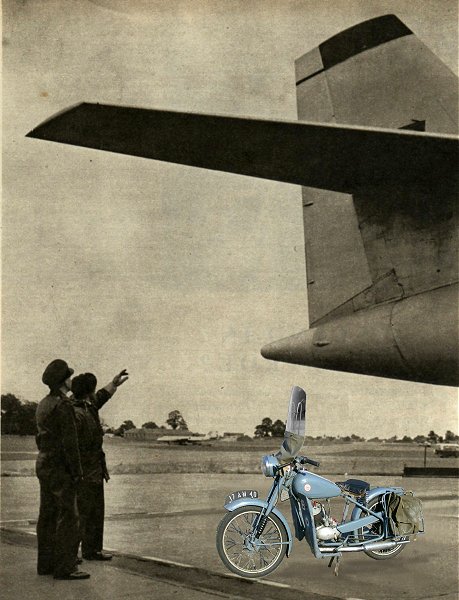
Our test machine parked under the tail of a Valiant bomber
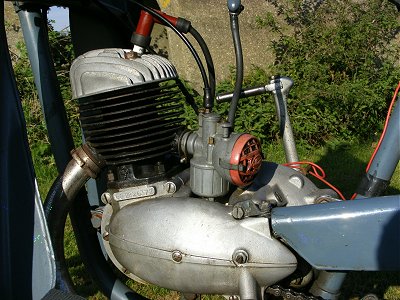
Starting should be a simple procedure with these flywheel magneto Villiers units, not even a key, Ewarts fuel tap pull for on, and normally expecting to flip the choke shutter on a Junior Type 6/0 carb, but instead we find a later type S12! A check on the engine number indicates it’s from a 1960 batch, so this bike’s had a transplant. Oh well, no matter, pull on the fuel tap plunger, and the S12 carb has choke slide and flood button … which to use? These things have quirky reputations for the correct procedure. Since Junior carbs on autocycles favour choked starting, we try that first … kick, kick, open throttle, kick, close throttle, kick … nope, that doesn’t seem to work. Take off the choke and try the flood … kick, kick, kick, open throttle, kick, kick, close throttle, kick, kick … nope, nothing either. Try the choke and flood … kick, kick, open throttle, kick, kick, close throttle, kick, kick, open throttle, kick, kick … nothing, not even an encouraging cough. Right, time for a shove, click the handlebar changer into second, back onto compression, clutch, run and bump (bloop, bloop, bloop), then wring open the throttle and—yes! The motor bursts into life with a strong and crisp exhaust tone, responding smartly to little tweaks on the throttle. The engine seems to run fine, but why wouldn’t it just kick-start? Two-strokeitus, or maybe we just don’t have the right technique!
Warm the motor, pop off the choke, clutch, and prepare to do battle with the wretched handlebar mounted gear change switch. It’s located on the right bar, so you have to release the throttle to push the lever fully forward and engage first. Back to the throttle, open up, feed in the clutch, and we’re off—then you’ve got to prepare to do it again, on the move this time, to pull the lever fully back and switch to second. It’s a slow and unsteady control method, meanwhile your right foot’s doing nothing, making you wonder why Villiers took so long to get from the cable change 1F in 1948, to the foot change 6F for 1957. Since our J11 Comet traps us in 1955, our wishful thinking only lasts as far as the junction at the end of the road, where we have to switch back down and start all over again.
Thumb the gear switch down to bottom, crank open the throttle, and progressively feed in the clutch to overcome the high first ratio, as the revs pick up our James pulls strongly, then switch into second and build up to a comfortable cruising speed around 35.
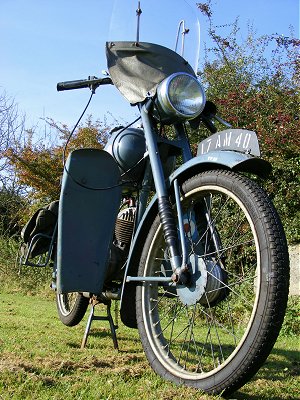

Our RAF Comet has a blanking plate in the headlamp where a speedo could be fitted as an accessory item, so once again we rely on our wing man to take the readings, and best on the flat was clocked by the pace bike at 37. There are only two gears, but the top notch generally feels to be overgeared, with the motor constantly labouring against the ratio. Only with the aid of gravity going downhill, do the revs seem to get up where you expect, and the pace bike chases us in a fast dive at a max of 44mph. Climbing up the other side, the speed just as rapidly falls away, and the 4F engine digs in to slog up the incline at a steady 30.
For only a 98cc machine, the Comet felt appreciably heavier than an autocycle when dragging it around, and rode heavier too, but also seemed better planted on the ground than its cycle-based forebears. Coupled with the coil-sprung saddle, the plunger rear suspension units effectively soaked up all the road turbulence so the pilot experienced no discomfort during our flight. The impression was certainly much more motor cycle than any autocycle it may have distantly derived from.

We did try the lights… Switching on, the headlight briefly illuminated then fizzled out as the bulb turned cloudy white. Simultaneously at the back, the red lens momentarily went supernova then fused the filament and plunged us into darkness. So, turning the switch back to the off position—that concludes the lighting test!
Where the preceding 1F motor reflected the 2F autocycle engine in general visual appearance, the 4F evolution has smooth casing lines with a smaller enclosed flywheel on the right, and ignition points moved over to the left hand crank. No autocycle motor variant followed this development.
The trigger gear change is such a pain to operate that you try to remain in top as much as possible and labour the motor. For its inconvenient design, 4F is a tough little nut though, and takes this in its stride. The motor’s performance is never going to challenge Comet’s stoutly built frame, which always handled confidently.
The rear brake proved very effective, though the leg shield crowded access to the foot pedal. The front brake was far less efficient, and not to be relied upon.
Further evolving, the 1956 Comet appeared as the L1 model, using a Cadet (125) frame with a cumbersome pressed steel rear section and swing-arm suspension. This heavy-metal diet bulked Comet’s dry weight up to 165lbs, while the sprung saddle became replaced by an ungainly half dual-seat, and it continued in much the same bloated form for another 8 years before finally being withdrawn at the end of the 1964 season.
As the AMC Empire crumbled, production of James branded motor cycles ceased in October 1966.
In 1997, former British Government owned de Havilland 4C Canopus, serial XS235, made the last documented Comet flight.
The Hawker Siddeley Nimrod, a military derivation of the Comet airliner, continues in service.
Next: The moped crusader heads toward Eastern Europe in what might seem to be a blood & guts medieval warrior epic, going by the title! Will our hero succeed in his quest to discover what tale lies behind The Golden Helmet?
This article appeared in the January 2009 Iceni CAM Magazine.
[Text & photos © 2009
M Daniels. Montage © 2009 A Pattle.
Period documents from IceniCAM Information
Service.]
Iceni CAM Magazine 8’s support feature Fly Me, like the Atco Trainer, was another of ‘The Mauritius Batch’ drafted over Easter of 2008, and one of several articles penned at this time. A busted cartilage three days beforehand, reduced the transit flights to a wheelchair to progress through the airport system, and time on the island limited to crutches. Not exactly up to chasing Dodos along the beaches, but it certainly created plenty of time for writing, so what wasn’t too good for the author, worked somewhat in favour of the IceniCAM readership. The featured RAF Comet came from Carl Harper, and part way through assembling the historical and technical text, came the unlikely inspiration of comparison to the de Havilland Comet airliner! The idea was just too original to miss the opportunity for such a unique theme, and would you ever get such a chance with any other bike? This was simply a ‘had to do’, and so it was that IceniCAM now came to find itself researching a classic jet!

Our RAF James Comet poses under the tail of a paraffin-drinking
Valiant bomber…
…no it doesn’t—we digitally removed the L1
Comet from the original 1957 picture,
and dropped our bike in!
Because we used all digital pics, this came in at the bargain basement cost of only £5 for fuel. East Anglian Cyclemotor Club member and James autocycle owner Jeff Lacombe scores another sponsorship credit for the Leicester Enthusiasts on the Comet mini-feature.
I would not like readers to get the wrong impression from Mark Daniels’s excellent article on the James ‘Comet’ that it is a difficult bike to ride. My 1952 Comet is more or less identical to the one reviewed except that it has the Villiers 1F engine which preceded the 4F fitted in the RAF bike. As far as I can see the gearchange mechanism is the same, although the gear change lever arrangement might be slightly different.
On my Comet the gear change is effected by a lever on the handlebar with a trip lever that releases it from the first gear position to allow the lever to snap through to the second gear position. So the procedure is to pull in the clutch lever, click the gear forward into first, ease off the clutch with plenty of throttle and when the bike is up to speed (probably 10mph if conditions allow) then de-clutch, pull in the release lever and it snaps into top and away you go!
Given the slogging nature of the 1F it’s only the steepest of hills that require a change down to first and this, I will agree, does require some practice. For all other stops, like traffic lights and such, you just push the gear lever forward to click into the neutral position, then when the lights go green it’s the starting from a standstill as described.
In riding a bike like this momentum is the key. You have to keep the bike rolling as fast as conditions allow, and keep the engine pulling at all times. In fact you might call the gears ‘Get rolling’ and then ‘Go for it!’. It’s piece of cake—as they used to say in the RAF.
John Hawthorn
| CAMmag Home Page | List of articles |